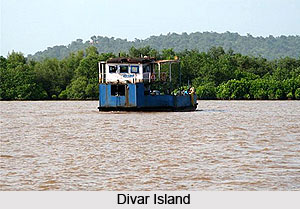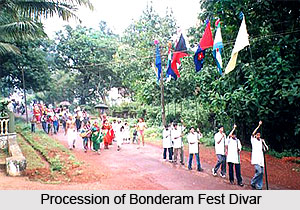 The Divar Island lies in the state of Goa in India. The name of Divar Island is derived from the word Dipavati or `Small Island` in Konkani. Divar Island is located approximately 10 km from Panaji (Panjim), and is approachable by ferry. The Island is connected to Old Goa on the south-east side, Ribandar,on the south-west side and Narve on the north side, all by ferry . A launch also connects Divar to the city of Panaji from further northwest, in the village of Vanxim. The Konkan Railway passes through the Divar Island and the nearest stop to the island is the train station at Karmali.
The Divar Island lies in the state of Goa in India. The name of Divar Island is derived from the word Dipavati or `Small Island` in Konkani. Divar Island is located approximately 10 km from Panaji (Panjim), and is approachable by ferry. The Island is connected to Old Goa on the south-east side, Ribandar,on the south-west side and Narve on the north side, all by ferry . A launch also connects Divar to the city of Panaji from further northwest, in the village of Vanxim. The Konkan Railway passes through the Divar Island and the nearest stop to the island is the train station at Karmali.
The drive to the Divar Island is scenic, with paddy fields and wooded hills lacing the roadway, very typical of the Goan countryside. Though in a manner equally typical of modern Goa, of late the paddy fields lie fallow and overrun with weeds.
The Divar Island was a famous site of Hindu pilgrimage and hosted the ancient temples of Shree Saptakoteshwar, Shree Ganesh and Shree Dwarkeshwar besides others. Portuguese zealots irreversibly destroyed these in the 16th century in their drive for Christianisation of Goa. The Current Cemetery near Church at hilltop once housed at Ganesh Temple, which was razed by the Portuguese and the Hindus had to take the Ganesh Idol and rehabilitate it in village of Khandola near Marcel. The ancient site of Hindu pilgrimage is called Porne Tirth (Old pilgrim spot-in Konkani) even today. Rui Gomez Pereira in his book Goan temples and deities writes, " The native temple (Of Shree Saptakoteshwar) was constructed in the 12th century by the kings of Kadamba dynasty. Shree Saptakoteshwar was the patron Deity of the Kadambas, however it was destroyed by the sultan of the Deccan in the middle of the 14th century and reconstructed at the same locality by Madhav Mantri of Vijaynagar at the close of the same century.
A Jesuit priest Fr Francisco Sousa documented the religious importance of "Divar Island" in his book Oriente Conquistado (Conquest of the orient) around the latter years of the 16th or early 17th century. Divar Island was as much venerated by the Hindu Brahmins as the Holy land, on account of a temple of many indulgences and pilgrimages. The linga of the temple is made of five metals, namely gold, silver, copper, iron and bronze was later relocated in Bicholim. And on the foundations of the same temple a prayer and catechism house was constructed in 1563.
The original inhabitants of Divar Island were people who once lived in Old Goa but had to desert during a disastrous plague that greatly reduced the population of Old Goa. Piedade is a small village is spread at the bottom of a small-forested hillock on Divar Island. There is the Church of Our Lady of Compassion. The island is dotted with well-maintained, elegant Portuguese villas. From the top of the hill, superb panoramic views of the surrounding countryside, including Old Goa, the capital of Goa, Panaji, the meandering Mandovi River, and the bridges across can be seen.
 The famous Bonderam festival is celebrated in Divar Island on the fourth Saturday of August during the monsoon season with great fanfare and attended by thousands of tourists and locals. Bonderam Festival is a memoir to the dispute and the fury of the Villagers over the Portuguese system of resolving the disputes. The villagers on the Divar Island often indulged in some kind of fight over the matter of ownership of their lands. To terminate the disputes the Portuguese, put up flags at the boundaries. The villagers did not like this system. So they protested against the Portuguese by throwing stones at the flags. On this day a carnival ambience is created. Each section of the village has a float at the parade. Melodious music could be heard throughout the village. The gaily-colored floats accompanied by colorfully dressed youngsters make a lovely picture.
The famous Bonderam festival is celebrated in Divar Island on the fourth Saturday of August during the monsoon season with great fanfare and attended by thousands of tourists and locals. Bonderam Festival is a memoir to the dispute and the fury of the Villagers over the Portuguese system of resolving the disputes. The villagers on the Divar Island often indulged in some kind of fight over the matter of ownership of their lands. To terminate the disputes the Portuguese, put up flags at the boundaries. The villagers did not like this system. So they protested against the Portuguese by throwing stones at the flags. On this day a carnival ambience is created. Each section of the village has a float at the parade. Melodious music could be heard throughout the village. The gaily-colored floats accompanied by colorfully dressed youngsters make a lovely picture.
The huge bell which today adorns the Se Cathedral in Old Goa was actually donated by the master of a sinking ship who`d made a vow that, were he to survive his fate, he would donate the ship`s bell to the first church village, town, or city his boat touched. It so happened that that the island was Divar Island. In keeping with his promise, he donated the bell to the Church of Divar Island, which is located on a high hillock. Unfortunately though, every time the bell was struck, it shattered the windows of the church and the houses in the vicinity, so a deal was struck and the bell was exchanged with that of the Se Cathedral.
Divar Island boasts a plethora of fine temples; most prominent amongst them is Shri Ganesh Sateri Temple at Sateri Bhat which also houses Khapro Ravalnath along with Sateri Mahamaya. There are two more Temples of Ganesh one at Navelim and other at Hilltop near the Church. Divar Island is a peaceful retreat and an excellent place for bird watching. There are many elegant villas with Goan balconies and deep verandahs, which add to the picturesque look of this island. The famous Bonderam festival on the 4th Saturday of August is celebrated in Divar Island with great pomp and festivity. On this day, this quiet island is filled with festivities. Ferries reach every half hour to Divar Island from Old Goa. Salim Ali Bird Sanctuary, the Crocodile Habitat and the world heritage monuments at Old Goa are nearby attractions of this popular Divar Island.



















